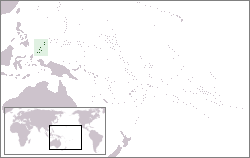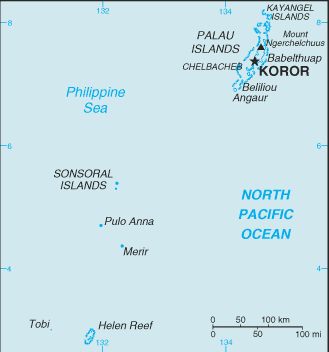Palau
| |||||
| National motto: Rainbow's End | |||||

| |||||
| Official languages | English, Palauan, Japanese | ||||
| Capital | Koror | ||||
| President | Tommy Remengesau | ||||
| Area - Total |
Ranked 179th 458 km² | ||||
| Population - Total (Year) - Density |
Ranked 190th 20,303 (2005 est.) 44/km² | ||||
| Independence | 1994 | ||||
| Currency | US Dollar | ||||
| Time zone | Universal Time + 9 | ||||
| National anthem | Belau loba klisiich er a kelulul (Palau Is Coming Forth with Strength and Power) | ||||
| Internet TLD | .pw | ||||
| Country Calling Code | 680 | ||||
The Republic of Palau is a borderless country in the Pacific Ocean, located some 500 km east of the Philippines. Having emerged from United Nations trusteeship (administered by the United States of America) in 1994, it is one of the world's youngest and least populated nations. It is sometimes referred to in English under its native name Belau.
Geography
Palau's most important islands are Angaur, Babeldaob, Koror, and Peleliu, which lie together near the same barrier reef. About two thirds of the population lives on Koror. North of these islands, the coral atoll of Kayangel is situated, while the uninhabited Rock Islands (Palau) (ca. 70) are situated to the west of the main island group. A remote group of six islands, known as the Southwest Islands, some 600 km from the main islands, is also part of the country.
History
Recent studies show Palauans may have come from China ([1]) or Indonesia, settling the islands as early as 2500 B.C.E. As it stands, this issue continues to be up in the air as the Palauan people remain an enigma to most of the world. Palau is located between several important geographical locations, —which is why it was the a top strategic location for nuclear weapons activities during the cold war era. Much coveted by Henry Kissinger, it is only "a few hundred miles from New Guinea," and a hop and skip to Guam, Australia, the Philippines, Japan, Bali, the former Soviet Union, Korea, etc. Kissinger was reasons in 1969 talking about Oceania saying, "There are only 90,000 people out there. Who gives a damn?"
In 2003 the world was startled by the discovery of the first confirmed hominid remains of Homo florensis in Java. This is significant because Palauan female money was imported from this locale but even more recent findings show the history of Palauan money beads can be traced to "Egypt". This is not surprising since historically the Phoenicians were the world's best navigators —a title usually given to Palauans.
The Spanish explorer Ruy López de Villalobos may have passed by one of the islands in 1543 but not enough information exists to prove Palau was ever in his sights. European attempts to settle on or trade with the islands were not successful until the 18th century, when the British ship-wrecked off Koror in 1783. Palau (land of fairy-tales) was dubbed « Pelew »).
With a mandate from the Vatican to convert the unsaved, Spain attempted to colonize the islands (« Palaos ») with little success in the late 19th century and lost them to Germany in 1899 (who called them « Palau »). Japan took over the islands at the start of World War I until the end of the Second World War, when the islands came under control of the United States as part of the Trust Territory of the Pacific Islands. The Palauans voted in 1979 not to join the Federated States of Micronesia based on language and cultural differences, choosing independence instead. After a long period of transition, including the violent deaths of two presidents (Haruo Remeliik in 1985 by assassination and Lazarus Salii in 1988 by suicide), Palau voted in 1994 to become freely associated with the United States while retaining independence. This Compact of Free Association was a hotly debated issue that Palauans voted down more than ten times since the 1970s, as provisions in the compact allow the United States broad powers, such as control of 51% of the island in time of national emergency and the ability to use the islands as a launching pad for nuclear warheads —contrary to Palau's no-nuclear policy. The United States especially desired further control of the Marianas Trench for submarine testing, allegedly because the trench is the deepest in the world. In the past 5 years, the United States has built a submarine base on the island of Guam (a U.S. territory), which is the southern-most of the Mariana Islands, for which the trench is named. More recently, however, an issue of greater concern has been addressed. On November 4, 2005, a former officer of the U.S. military blew the whistle on clandestine military operations. Guam water tested positive for radiation fallout from two thermonuclear bomb tests in 1952, but this information was kept secret for five decades and is only beginning to come to light. Being such a close neighbor to Guam, this brings undue concern to the inhabitants throughout all of Micronesia and definitely concerns Palauans who are in very close proximity.
Politics
The president of Palau, who is both head of state and head of government, is elected by the Palauans every four years. The government headed by the president consists of a bicameral parliament, known as the Olbiil Era Kelulau. The members of both chambers are chosen by the people; 9 are part of the Senate, and 16 of the House of Delegates. The current president is Tommy Remengesau. He was elected in 2000 and took office in 2001. He had previously served as vice president. He was re-elected in 2004.
Climate
Palau enjoys a tropical climate all year round with an annual mean temperature of 82 °F (27 °C). Rainfall can occur throughout the year, the annual average is 150 inches (3,800 mm). The average humidity is 82%, and although rain falls more frequently between July and October, there is still much sunshine. Typhoons are rare as Palau is outside the typhoon zone.
Economy
The economy consists primarily of tourism, subsistence agriculture, and fishing. The government is the major employer of the work force, relying heavily on financial assistance from the US. Business and tourist arrivals numbered 50,000 in the financial year 2000/2001. The population enjoys a per capita income twice that of the Philippines and much of Micronesia. Long-run prospects for the key tourist sector have been greatly bolstered by the expansion of air travel in the Pacific, the rising prosperity of leading East Asian countries, and the willingness of foreigners to finance infrastructure development.
In July 2004, Palau Micronesia Air was launched with service from Palau to Yap, Guam, Micronesia, Saipan, Australia, and the Philippines. Unfortunately, it ceased operations in December of the same year and has not restarted operations since.
Demographics
The population of Palau is approximately 19,000. The major ethnic group (70%) is the native Palauans, who are of Melanesian Micronesians, andPolynesians. Indo-Europeans, Asians and Europeans account for the minority groups. Two thirds of the population are said to be Christians (mainly Catholics and Seventh-day Adventists), but Modekngei (a combination of Christianity, traditional Palauan religion and fortune telling) and the Ancient Palauan Religion is still the most commonly observed household religion.
The official languages of Palau are Palauan and English, except for three states (Sonsorol, Hatohobei, and Anguar) where the local language is official instead of Palauan. In Angaur, Japanese is also official.
Culture
External links
- Elizabeth Bassett's Palau
- myMicronesia/Palau section
- Olekoi Palau
- Palauan embassy to the United States Official Website
- Palauan Pride Online
- WWFM 89.5 Radio
- East Javanese Beads as Palau Heirlooms
- Palau photographs
- Travel Notes - Runoko Rashidi in the Republic of Palau
Credits
New World Encyclopedia writers and editors rewrote and completed the Wikipedia article in accordance with New World Encyclopedia standards. This article abides by terms of the Creative Commons CC-by-sa 3.0 License (CC-by-sa), which may be used and disseminated with proper attribution. Credit is due under the terms of this license that can reference both the New World Encyclopedia contributors and the selfless volunteer contributors of the Wikimedia Foundation. To cite this article click here for a list of acceptable citing formats.The history of earlier contributions by wikipedians is accessible to researchers here:
The history of this article since it was imported to New World Encyclopedia:
Note: Some restrictions may apply to use of individual images which are separately licensed.
